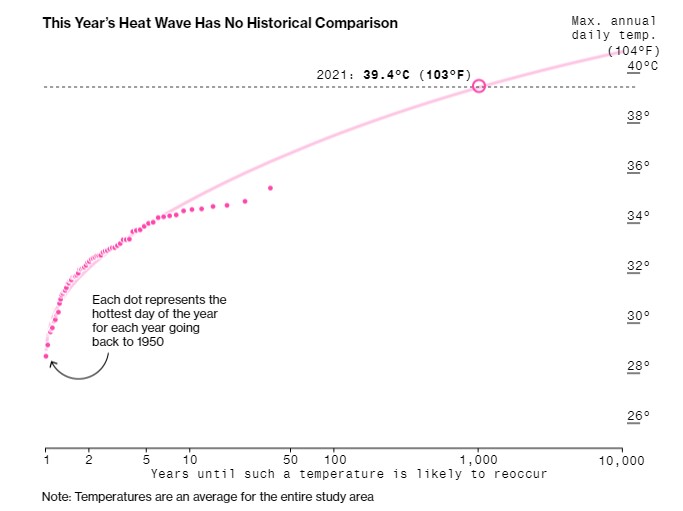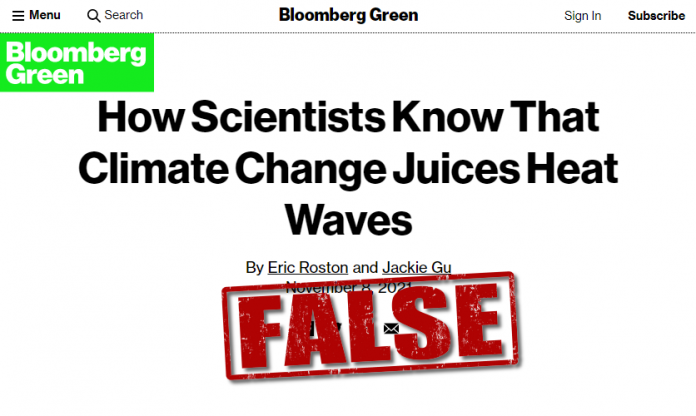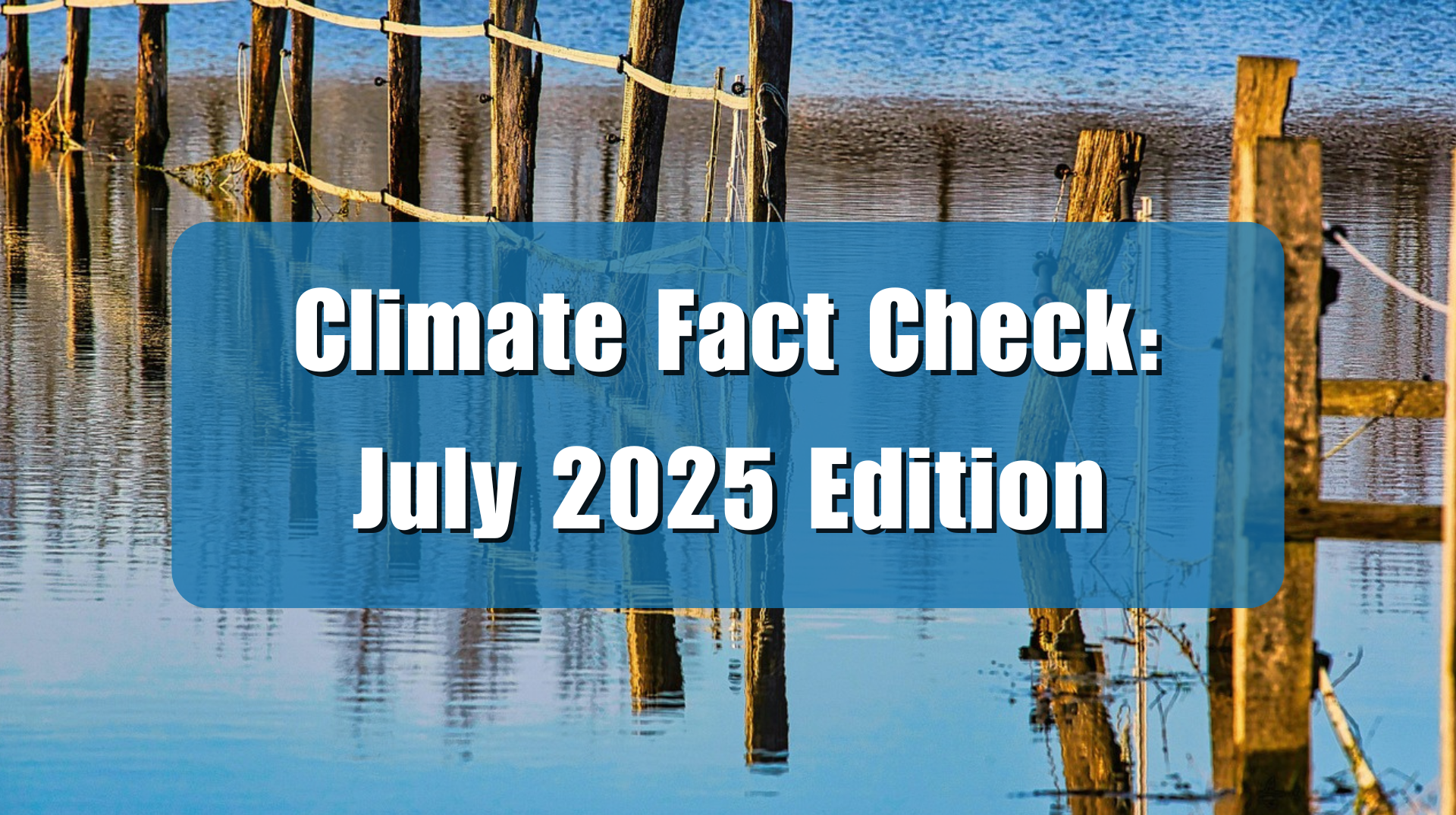A recent article in Bloomberg News, titled “How Scientists Know That Climate Change Juices Heat Waves” cites the work of a recently minted organization that calls itself “World Weather Attribution” (WWA). The WWA claims it can link specific weather events to climate change purportedly driven by human greenhouse gas emissions. This is false. In order to drive political action on climate change, WWA purposefully conflates weather with climate, ignoring the well-defined scientific distinction between the two.
World Weather Attribution examines particular extreme weather events, and uses computer models to calculate the probability that a particular event would have occurred in the affected area absent the addition of human greenhouse gas emissions. Predictions like this are the work of Vegas oddsmakers and bookies, not scientists.
Bloomberg’s article promotes WWA’s claim that the Great Pacific Heatwave in June 2021 was driven by human caused climate change.
As a historic heat wave paralyzed the North American Pacific coast on June 28, a group led by researchers in the U.K. and Netherlands called World Weather Attribution gathered virtually to start a task that just a few years earlier many had considered impossible. They would rapidly diagnose climate change’s impact on weather.
Within nine days, they reported that the unprecedented temperatures were “virtually impossible” without climate change. Greenhouse gases made them likelier by at least a factor of 150.
. . .
The team had to adjust its standard approach, because it suggested the heat wave actually under way was so severe that it couldn’t be happening.”
For evidence, WWA cites the graph shown below, which it claims to depict the hotter the event is (right axis), the rarer it is (bottom axis). Essentially, with this graph, they claim to know the weather and temperature back 10,000 years.

It is impossible for Bloomberg or WWA to know whether or not weather driven heatwaves events like the one the Pacific Northwest experienced this year have or have not occur multiple times in the last 10,000 years.
No actual weather records exist back that far. Native Americans neither had modern temperature and weather monitoring devices, which didn’t start to be installed the Pacific Northwest until the late 1800s, nor did they keep written records of daily weather. Also, weather events like short-term heat waves, as opposed to long term events like multi-year or multi-decade droughts or volcanic eruptions, aren’t discernable from proxy data used to reconstruct the historical climate.
Lacking actual measurements and even proxy data, they insert assumptions into computer models concerning past temperatures, and then use its simulated outputs to estimate the odds that events such as the recent heat wave occurred in the past and how often. In a nod to real science, WWA does not claim certainty about their claims. All they produce are estimates and probabilities. As Bloomberg writes:
“With an understanding of the area’s climate history, the members then simulate the same event in two different virtual worlds, with and without greenhouse-gas pollution. Comparing the model results allows them to conclude two things: how much likelier the heat wave is today than it would have been, and how much higher climate change pushed temperatures.” (emphasis mine).
Virtual worlds aren’t real worlds, and something being likelier or “likelier to reoccur” or not, is not the same as knowing that it has or has not or will or will not occur. Basing claims of past and future temperatures on computer models which admittedly grossly overestimate present warming should not instill confidence in Bloomberg or anybody else that WWA’s claims should be given credence.
Even worse for WWA, the graph itself shows they were dishonest, because their estimates only go back to 1950. As a result their data begins at a time when the earth went through a period of modest cooling, despite the fact that actual weather data for the area goes back as far as 1870.
For example, Seattle’s first official weather report was made on February 16, 1870, a 55-degree day with clear skies and no rain.
The official all-time June record for Seattle is 98 degrees, set on June 25, 1925, and there was the July 16, 1941 reading of 100 degrees. If WWA had included those readings and others in the area at the time, instead of cutting it off at 1950, their graph would have a cluster of dots at the top, and wouldn’t be at all persuasive. WWA excluded inconvenient high temperature data pre-1950, enabling them to make a false claim that fit their agenda. That’s called cherry-picking the data, an all too common practice among alarmist climate scientists.
Cherry-picking, defined:
Cherry picking, suppressing evidence, or the fallacy of incomplete evidence is the act of pointing to individual cases or data that seem to confirm a particular position while ignoring a significant portion of related and similar cases or data that may contradict that position.
It’s just another case of How To Lie With Charts, a well known problem, especially in “climate science”.
It is therefore meaningless to claim anything from the dishonest WWA graph.
In point of fact, the WWA’s claim that the recent heat wave event produced “… unprecedented temperatures [that] were “virtually impossible” without climate change” is refuted by real-world temperature data.
Cliff Mass, Ph.D., a meteorology professor from the University of Washington in Seattle, right in the middle of the heatwave, did a detailed analysis of the heat wave, which he presented an article, titled “Was Global Warming The Cause of the Great Northwest Heatwave? Science Says No.”
Mass writes:
Unfortunately, there has been a substantial amount of miscommunication and unscientific handwaving about the recent Northwest heatwave, and this blog post uses rigorous science to set the record straight.
First, the specific ingredients that led to the heatwave are discussed, including a high-amplitude ridge of high pressure and an approaching low-pressure area that “supercharged” the warming. Second, it is shown that global warming only contributed a small about (1-2F) of the 30-40F heatwave and that proposed global warming amplification mechanisms (e.g., droughts, enhanced ridging/high pressure) cannot explain the severe heat event.
It is shown that high-resolution climate models do not produce more extreme high temperatures under the modest global warming of the past several decades and that global warming may even work against extreme warming in our region.
Mass also found no trend consistent with “climate change” aka “global warming” and came to this conclusion:
“If global warming was producing extreme heatwaves in our region, such as the event last week, there would be a long-term trend towards more extreme high temperatures,” Mass wrote. “A single event does not reflect climate, only a trend or changes in long-term average do.”
Mass went on to examine the long-term temperature data reporting, using all of the available weather data back 120 years finding “…there IS NO INCREASING TREND for more record high temperatures over our region during the past century. “
Data demonstrates no connection between “global warming” aka “climate change” and this 3-day heat wave event. Despite this fact, activists posing as scientists are producing false narratives and false graphs to claim such a connection exists.
Compounding error upon error, Bloomberg and other corporate media outlets, compliantly and unquestioningly simply regurgitate WWA’s unsupportable claims as if they are proven facts, rather than doing a bit of investigative research concerning them. Bloomberg’s story is a gross breach of journalistic integrity. The Society of Professional Journalists code of ethics specifies “[e]thical journalism strives to ensure the free exchange of information that is accurate, fair, and thorough.” Bloomberg’s story on the WWA’s heat wave claims meets none of these conditions.
Unfortunately, bad science and bad science reporting have become all too common in the discussion of climate change.
It is a sad and dangerous state of affairs.
























